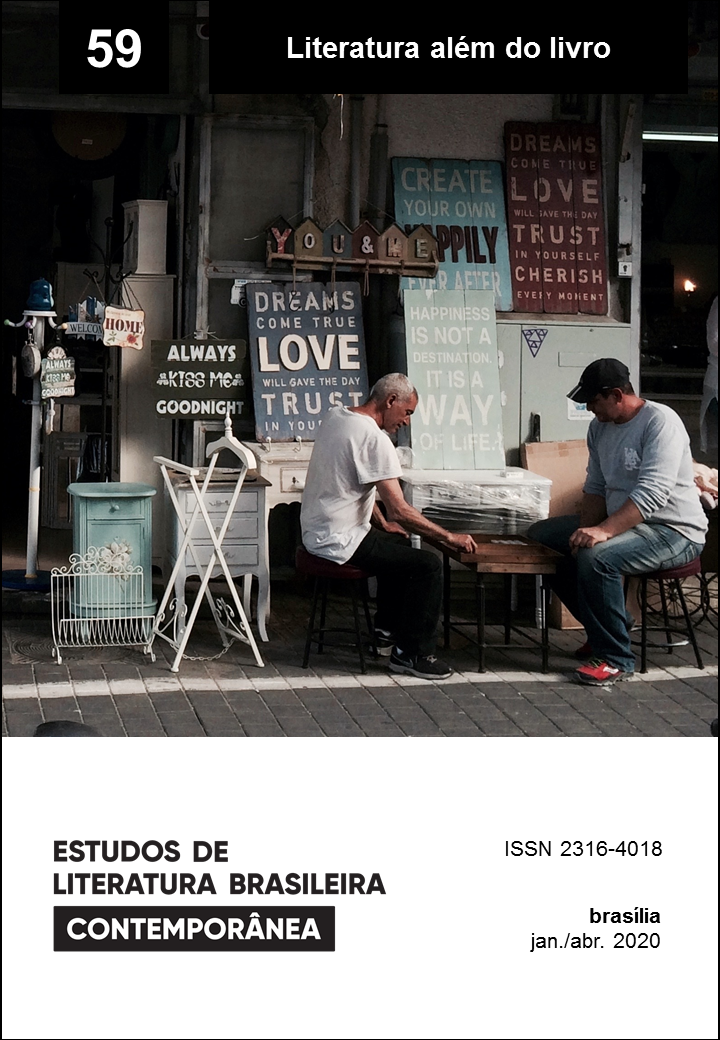Thinking multiplicity in fictional hyperconcision: contemporary Brazilian flash fiction (2000-2017)
DOI:
https://doi.org/10.1590/2316-4018592Keywords:
flash fiction, Contemporary Brazilian Literature, postmodernityAbstract
Born of the modernist and avant-garde period, flash fiction is one of the most emblematic literary reflections on life in the new millennium, and Latin America plays a significant role in the production of this genre. In this paper, we analyze the current panorama of Brazilian flash fiction, examining its most representative tendencies and the authors and works that have contributed to these characteristics.
Downloads
References
BAGGIO, Mário (2017a). Contos Mínimos # 831 a 840. Homem de Palavra: o blog do Mário Baggio, São Paulo, 28 nov. On-line. Disponível em: http://homemdepalavra.com.br/contos-minimos-831-840/ Acesso em: 25 ago. 2018.
BAGGIO, Mário (2017b). Contos Mínimos # 821 a 830. Homem de Palavra: o blog do Mário Baggio, São Paulo, 7 nov. On-line. Disponível em: http://homemdepalavra.com.br/6331-2/ Acesso em: 25 ago. 2018.
BAGGIO, Mário (2017c). Contos Mínimos # 811 a 820. Homem de Palavra: o blog do Mário Baggio, São Paulo, 23 out. On-line. Disponível em: http://homemdepalavra.com.br/contos-minimos-811-820/ Acesso em: 25 ago. 2018.
BONASSI, Fernando (2001). Passaporte. Rio de Janeiro: Cosac & Naify.
BRASILIENSE, Leonardo (2007). Adeus conto de fadas. Rio de Janeiro: 7 Letras.
BRASILIENSE, Leonardo (2014). Corpos sem pressa. Porto Alegre: Editora Casa Verde.
BUSTAMANTE VALBUENA, Leticia (2016). La contaminación como recurso creativo en el microrrelato. In: ÁLVAREZ RAMOS, Eva; MARTÍNEZ DEYROS, María (Orgs.). Historias mínimas, estudios teóricos y aplicaciones didácticas del microrrelato. Valladolid: Cátedra Miguel Delibes. p. 151-168.
CARRASCOZA, João A (2016). Linha única. São Paulo: Editora SESI-SP.
COLASANTI, Marina (1975). Zooilógico. Rio de Janeiro: Nórdica.
COLASANTI, Marina (1978). A morada do ser. Rio de Janeiro: Civilização Brasileira.
COLASANTI, Marina (1986). Contos de amor rasgados. Rio de Janeiro: Rocco.
COLASANTI, Marina (2013). Hora de alimentar serpentes. São Paulo: Global Editora.
DEGRAZIA, José Eduardo (1996). O atleta recordista. Porto Alegre: Movimento.
DEGRAZIA, José Eduardo (1998). A orelha do bugre. Porto Alegre: Movimento.
DEGRAZIA, José Eduardo (2016). A colecionadora de corujinhas. Porto Alegre: Bestiário.
DEGRAZIA, José Eduardo (2018). Notícias em três linhas. Porto: Exclamação.
FERREIRA, Ana Sofia Marques Viana (2016). Potencialidades del microrrelato em internet. Revista Matlit, Coimbra, v. 4, n. 2, p. 207-231.
FIALHO, Henrique Manuel Bento (2008). Esboço para um ensaio sobre micronarrativa. In: COSTA, Rui; SEBASTIÃO, André (Orgs.). Primeira antologia de micro-ficção portuguesa. V. N. Gaia: Êxodus, p. 9-19.
FREIRE, Marcelino (Org.) (2004). Os cem menores contos brasileiros do século. São Paulo: Ateliê.
GENETTE, Gerard (1989). Palimpsestos: la literatura en segundo grado. Tradução de Celia Fernández Prieto. Madrid: Taurus.
MESQUITA, Samir (2007). Dois palitos. Disponível em: http://www.samirmesquita.com.br/doispalitos.html. Acesso em: 15 set. 2018.
MESQUITA, Samir (2009). 18:30. Disponível em: http://www.samirmesquita.com.br/. Acesso em: 15 set. 2018.
NÊUMANNE, José (1992). Prefácio. In: EMEDIATO, Luiz Fernando. A grande ilusão. São Paulo: Geração.
NOGUEROL, Francisca (1996). Micro-relato y posmodernidad: textos nuevos para el final de milenio. Revista Interamericana de Bibliografía, Sevilla, n. 1-4. On-line. Disponível em: https://bit.ly/2NlQkyo. Acesso em: 15 set. 2018.
NOLL, João Gilberto (2003/2015). Mínimos, múltiplos, comuns. 2. ed, Rio de Janeiro: Record.
QUEIROZ, Eça de (1983). A perfeição. Contos. Lisboa: Livros do Brasil.
REZENDE JUNIOR, José (2010). Estórias mínimas. Rio de Janeiro: 7 Letras.
ROSSATO, Edson (2010). Cem toques cravados. São Paulo: Andross.
SCHØLLHAMMER, Karl Erik (2004). Miniatura e fragmento: brevíssima incursão pelas formas breves do Brasil. In: NOGUEROL, Francisca (Org.). Escritos disconformes. nuevos modelos de lectura. Salamanca: Ediciones Universidad de Salamanca. p. 153-162.
SEABRA, Carlos (2015). MiQRocontos. Disponível em: http://seabra.com/qrcontos. Acesso em: 15 set. 2018.
SHAKESPEARE, William (1984). Hamlet. Príncipe da Dinamarca. São Paulo: Ediouro.
SOUZA, Fabrina Martinez de; RODRIGUES, Rauer Ribeiro (2012). A ascensão do microconto brasileiro no início do século XXI. In: ÁLVARES, Cristina; KEATING, Maria Eduarda (Orgs.). Microcontos e outras microformas. Minho: Húmus. p. 73-80.
TREVISAN, Dalton (2004). Arara bêbada. Rio de Janeiro: Record.
TREVISAN, Dalton (2007). 99 carnívoras nanicas. Porto Alegre: L&PM Pocket.
TREVISAN, Dalton (2008). Duzentos ladrões. Porto Alegre: L&PM Pocket.
TREVISAN, Dalton (2008). Maníaco de olhos verdes. Rio de Janeiro: Record.
TREVISAN, Dalton (2010). 111 Ais. Porto Alegre: L&PM Pocket.
TREVISAN, Dalton (2013). Desgracida. Rio de Janeiro: Record.
Downloads
Published
How to Cite
Issue
Section
License
Authors who publish in this journal agree to the following terms:
a) The authors maintain the copyright and grant the journal the right of first publication, the work being simultaneously licensed under the Creative Commons Attribution License-Non Commercial 4.0 which allows the sharing of the work with acknowledgment of the authorship of the work and publication this journal.
b) Authors are authorized to enter into additional contracts separately, for non-exclusive distribution of the version of the work published in this journal (eg publish in institutional repository or as a book chapter), with authorship recognition and publication in this journal.
c) Authors are allowed and encouraged to publish and distribute their work online (eg in institutional repositories or on their personal page) after the editorial process, as this can generate productive changes, as well as increase the impact and citation of published work (See The Effect of Free Access).
d) The authors of the approved works authorize the magazine to, after publication, transfer its content for reproduction in content crawlers, virtual libraries and the like.
e) The authors assume that the texts submitted to the publication are of their original creation, being fully responsible for their content in the event of possible opposition by third parties.


